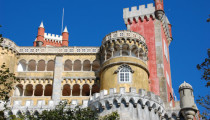February 6, 2009
5 Introductory Flavors of Peru
Peru is becoming a major foodie destination. For first-time visitors, here’s what to be sure to try while traveling in Peru, along with a few suggestions for the best places to sample each item.
1. Ceviche
Made of raw seafood, marinated and essentially “cooked” in a citrus-based mixture, a fresh ceviche may end up being the highlight of all of your meals in Peru. Some believe ceviche originated through a combination of pre-Hispanic, Incan and Spanish influences. Others believe it was invented by hungry fishermen who ate fish directly from the sea with just a little bit of lemon and salt. Whatever the case, ceviche is considered the national dish of Peru, and a visit to a cebicheria is a must during any trip to Peru. For an upscale twist, we recommend a visit to Lima’s La Mar Cebicheria, headed by Peru’s most renowned chef, Gaston Acurio. Besides a classic ceviche, Chef Acurio creates a number of innovative variations of the dish such as eisha (king prawns, mango and granadilla) and the Japanese-influenced nikei (yellow fin tuna and sesame). This hotspot is only open for lunch and reservations are not accepted so we recommend arriving early to stake your spot.
Serious ceviche aficionados will also appreciate a day spent with one of our culinary experts in Lima. We arrange for travelers to explore Lima’s best fish markets, followed by a ceviche lesson and tasting at one of Lima’s most authentic cebicherias that is a favorite of local Limenos.
2. Pisco Sour
With the first sip of a true Pisco Sour, you’ll know you are in Peru. Today’s classic version of the Peruvian Pisco Sour cocktail is a frothy mix of Pisco, simple syrup, lemon juice, egg white, ice, and a drop of bitters. The origin of Pisco, a clear spirit distilled from fermented grape juice, is fiercely debated by both Peru and Chile, with each country claiming it as their own national drink. To take it a step further, both countries also argue about the origin of the Pisco Sour cocktail. Chileans insist it was created in their country in the 1870’s by an English ship steward experimenting with local Piscos and sweet limes. Peruvians disagree and say the Pisco Sour was created in a bar in Lima in the 1920’s by an American expat named Victor “Gringo” Morris. Either way, Pisco Sours are the perfect treat for anyone wishing to sit back and relax with a delicious cocktail during their journey through Peru.
For those interested more in the “Pisco” than the “Sour,” you might like to have us arrange an afternoon spent tasting Peruvian Piscos with an expert at one of Lima’s traditional bars or Pisco shops.
3. Cuy (guinea pig)
It can difficult for foreigners to try cuy since we often think of guinea pigs as our furry little friends rather the main course at dinner. But to Peruvians, cuy is considered a delicacy and has been a part of the Andean diet for centuries. In pre-Colombian times, cuy was served only to the nobility and even used as a sacrifice or a means to predict the future via the entrails. These days, the method of preparation varies by region. In some areas it is baked or fried, but in the Cusco area, cuy is often roasted whole in a wood-fired oven. The guinea pig is stuffed with the Andean herb huacatay and a spicy pepper placed in the mouth. The taste is quite delicious and the meat can be compared to rabbit. We recommend an evening at the Inka Grill, one of Cusco’s most renowned restaurants serving Novoandean and Criolllo dishes, including a roasted cuy with rosemary and mirasol chili pepper.
For travelers interested in learning more in-depth about traditional Novoandean cuisine, we take them to a small village outside of Cusco that is renowned for its roasted cuy. There you can see the road lined with the traditional ovens, all roasting cuy and potatoes. We can also arrange a visit a traditional Quechua home in the Sacred Valley where one can see how families raise guinea pigs–with hundreds of them running around free right in their home! I’d encourage any adventurous eater to give cuy a try. You just may be pleasantly surprised or, at the very least, you will have a good story to tell when you get home.
4. Arequipa chocolate
No visit to the beautiful colonial “White City” of Arequipa is complete without a stop at one of its famous chocolate shops. Our personal favorite is La Iberica which was founded in Arequipa in 1909. Since then, La Iberica has become one of Peru’s foremost chocolate companies, producing high quality chocolates based on original homemade Spanish recipes and using the purest South American cocoa.
5. Coca & Muna Tea
When traveling to places like Cusco (11,150 ft. above sea level), Lake Titicaca (12,500 ft.) and the Patapampa Pass (15,750 ft.) en route to the Colca Canyon, it’s easy to become affected by the high altitude. Besides providing our travelers with oxygen in the car at all times, we recommend moving at a slow pace, getting some rest, and drinking lots of coca or muna tea in order to keep the effects of altitude sickness at bay. Coca tea is brewed by soaking the leaves of the coca plant in hot water which releases stimulants that provide an energy similar to coffee. The tea is believed to relieve potential headaches and nausea. Another recommended tea is brewed with a local herb called muna, an Andean mint. Muna can be found growing wild in many areas throughout Peru and the plant gives off an intense minty aroma. Crush the herb in the palms of your hands and inhale deeply to relieve respiratory issues, awaken the senses, and clear your head.
These wonderful tastes of Peru can be incorporated into any of our private Peru tours.
-S.S.
Destinations: Peru, South America
Tags: culinary tours, food, food tours, Lima, Peruvian flavors, travel

 MENU
MENU



